Menus
- A complement to the Chief range: the 1811 cm3 light tourer, at € 27,000
- Easily removable windshield and hard saddlebags, cruise control as standard, 372 kilos dry
- Discovery
- In the saddle
- In the city
- On highways and main roads
- On departmental
- Part-cycle
- Brakes
- Comfort / duo
- Conclusion
A complement to the Chief range: the 1811 cm3 light tourer, at € 27,000
Easily removable windshield and hard saddlebags, cruise control as standard, 372 kilos dry
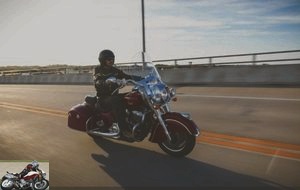
In this essay, the Biker Den may teach you (at least) three things. Do not thank us: contributing to the elevation of your biker culture is a priesthood; sharing a common passion is a mission.
For the first, let’s start with a little lesson in marketing: in France, the range of big Indian represents about half of the sales of the American manufacturer, the other half being made up of the Scouts. Second point: among the large models equipped with the V2 111 ci (1811 cm3), the customer has the choice between the “basic” Chief (a somewhat reductive term for a machine with an already exceptional finish and sold for € 22,600) and its all-black Dark Horse version (22 600 € also), the Chief Vintage and its “western” paraphernalia (spoked wheels, whitewall tires, saddle and soft saddlebags in natural leather with buffalobillesque fringes that go well, from 26 700 €), the Chieftain with its fork crown and its rigid cases (27 550 €), all this being supervised by the Roadmaster (29 400 €), which bears its name very well.
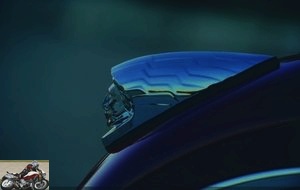
Well, if by chance (but then, really, by the greatest of luck), we risked a parallel with the Harley-Davidson range, (you will indeed agree that this is not a spontaneous intellectual approach ), we could have fun putting motorcycles from Milwaukee in front of those from Spirit Lake (Iowa). Indian Scout Sixty and Scout? Easy answer: Harley Sportster 883 and 1200. Indian Chief Classic? There it is a little more complicated: say, Fat Boy, Softail Slim and Slim S, Softail Deluxe. Chief Vintage? Too simple: Heritage Softail Classic. Chiefmaster? Childish: Street Glide. Roadmaster? There, even a failed candidate for the casting of Chtis in Miami would have the answer: Electra Glide.
And the Harley-Davidson Road King, in all of this, she doesn’t have a girlfriend, the Road King? Should we call SOS Amitie ?
Discovery
Well no, no more need to call SOS Amitie! The Road King now has a friend, if not a competitor, and this is the third piece of information in this test, which we will carry out until the end. With the Springfield, which was officially unveiled during Daytona Bike Week, Indian arrives in a new niche: that of light tourers. Well, light, that’s a way of speaking, because the machine is still 1811 cm3 and 372 kilos dry, but still remains light compared to other behemoths of the Interstates. Like what, everything is relative.

By the way, why Springfield? Isn’t that a weird name for "Spring Field"? In fact no, because it was in Massachusetts that the Indian brand was born in 1901, in the small village of Springfield. Homer Simpson fans know that Homer also resides in the city of Springfield. This is the fourth info: bonus gift !
End of the cultural parenthesis. The Springfield’s touring skills are embodied by the removable windshield and rigid saddlebags, also removable while having a central locking (controlled by a button on the center console or via the transponder): pragmatism and technology are not incompatible values. The rigid suitcases come from the Chieftain. A pair of additional lights is also part, as well as footrest plates for the passenger.
Built on a Chief base, the Springfield does not put us in new territory. Nevertheless, it evolves in detail: the Indian badge on the tank is new, as is the handlebars, which the Spirit Lake firm describes as being in the shape of an ox horn. It is intended to be a little more arched, closer to the driver and the angle at the handles gives the hand a more natural position. In detail, but not only: after all, Indian could have glued hard suitcases and stick wheels to a Vintage and presto, neither seen nor known, I’m confusing you.

This would be without taking into account the respect for the customer which is one of the founding values of the Spirit Lake firm. Because scientific marketing studies have shown that the owner of Chief Vintage is a contemplative: he rides cool, a lot in a straight line and does not throw himself on the chord points of the turns as if they had insulted his sister. The future owner of Springfield, on the other hand, is willing to forgo the fringes in exchange for a little more dynamism. Understand by this that the front axle of the Springfield is different from that of the Vintage (and, beyond that, also different from those of the Chiefmaster and Roadmaster, which must support fork heads equipped with much heavier electric bubble systems) . Yes, at Indian, we think of everything.
In the saddle
If you’ve never grasped ox horns, the Springfield’s handlebars will give you the chance. The good news is, it’s not scary, quite the contrary. The ergonomics are natural, without the excesses sometimes encountered on American machines and the low saddle height (660 mm) allows everyone to put their feet on the ground. And despite the heavy weight (372 kilograms dry, it should be remembered), the low center of gravity and the natural balance of the machine don’t make it particularly intimidating to drive. On the contrary, even, it is surprisingly easy.
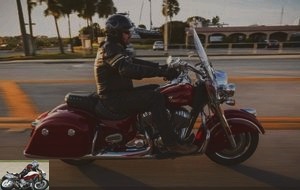
On the handlebars, therefore, we find ourselves a spectator of a universe of chromed metal. It shines ! In front of you, the solid headlight cowling, the handlebars, the voluminous real metal stems, the inner fairing of the fork, all this sparkles in the sun! There you have to admit the obvious: the feeling of quality and workmanship are simply exceptional, with incredible attention to detail, like the front brake master cylinder cover inlaid with a finely encrusted "Indian" lettering. chiseled. By widening the horizon a little, the quality of the paints, the leather of the saddle, the surface treatments of the engine, the integration of the wiring in the handlebars, all this places the Springfield in particular and the Indians in general in the category of truly premium motorcycles, without a shadow of a doubt. The exception, however, suffers from two small approximations: the plate and the mounting screw of the passenger seat are not very neat and the rear light seems to come straight from a commoner Kawasaki VN 1700. But for the rest, c ‘is beautiful, it’s clean, it’s very well done, it’s rewarding and above all, it seems built to last.
On the surface, the Springfield’s dashboard is simple: at the top left, a fuel gauge. To its right, the power button, whose graphics nod to that of Apple or the Wall-E robot; there is no ignition key, since a transponder that you keep in your pocket authorizes the start. Below the fuel gauge, the large meter incorporates a digital window which, thanks to a button on the left index finger, scrolls through the functions: average and instantaneous consumption, range, engine speed, two trips, temperature, pressure tires. Simple, therefore, but complete.
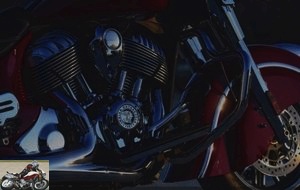
The big V2 comes to life with pressure on the starter, before stabilizing at a fairly low idle, between 750 and 800 rpm. Rather inert at low revs, it has a unique, rich personality with variations in range as well as astonishing strength and liveliness between 3000 and 5000 rpm. Always available, generous and refined at the same time, suave or energetic on demand, gurgling at idle and rumbling at full load, it is reminiscent of a tumbled V8, the other benchmark engine in American culture.
In the city
You may not need a touring motorcycle, even a light one, to go shopping in town. In this case, the Springfield’s first argument lies in its versatility. The windscreen ? 3 seconds are enough to remove it, thanks to two clips at the fork triple trees. For the saddlebags, you have to, come on, about ten seconds: remove the side cover, disconnect the plug that controls the central locking, then open the cover and press two buttons to release them. Child’s play….
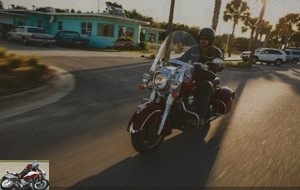
If she has proven to be perfectly at ease parading in the city of Daytona Beach (Florida, USA), one can imagine Springfield a little more embarrassed with the spines on the Paris ring road. However, the balance of the chassis, which has excellent self-stability at very low speeds and allows you to make U-turns without suffering, makes the task much easier. Just like the V2, whose velvety, roundness and flexibility allow it to start again from the idle speed on the lower gears of the box, or even to turn in a street at right angles while remaining in third. In fact, Springfield is surprisingly comfortable in the city. And in addition, it will attract some attention, because the Indian badge carries a beautiful image that opens up discussions on the sidewalks and red lights..
On highways and main roads
There, we can give the Springfield its attributes of traveler, by handing over the suitcases and the windshield. At 130 km / h, the big V2 is spinning at exactly 3000 rpm and we objectively have the feeling that it could go to the end of the world, notwithstanding the oil changes to be made every 8000 kilometers. We were unable to measure consumption on this test, but the 20.8-liter tank should provide 300 kilometers of autonomy..
The Springfield’s bubble is a little lower than that of the Chief Vintage, in accordance with the more “dynamic” temperament of its supposed owner. In use, it offers good protection, a large pilot (1.88 m) seeing the air flow deflected to the top of the helmet; likewise, the lower part of this bubble effectively protects the knees. On the other hand, we note the presence of aerodynamic eddies behind the bubble, which become more and more present from 140 km / h. If the V2 has resources, the spirit of the Springfield does not reside in the speeds of supersonic cruises and on its handlebars, we especially want to appreciate the passing time, despite the barbelivian (or Proustian, sounding) according to the level of culture of each and everyone) of this formulation.

The speed regulator is delivered as standard. Its handling is perfectly intuitive via the buttons on the right stalk. So it’s no mystery: the Springfield will be perfectly comfortable cruising the long American straights..
On departmental
At 90 km / h in 6th gear, the V2 runs at an extremely peaceful 2100 rpm. From a mechanical point of view, the V2 has a split personality. He loves to dawdle on a trickle of gas at low, even very low revs, and thus allows economy of gear changes, which is not a punishment, as the box has straightforward but not firm locks; on the other hand, we would not have had anything against the presence of series of a double branch selector, in order to accelerate by up the gears with a decided heel kick. That too is part of American culture (even if sources refer the authorship of the double branch to the 1971 Moto Guzzi California).
The Indian Springfield is also not shy about letting off steam, which it has 4 in all. Because its roundness at low revs and the long pull of its throttle grip could mask its true temperament. From 3,000 to just over 5,000 rpm, with a frank twist of the grip, the Indian is both crisp and powerful and, frankly, quite stunning. There, there is no doubt that the 139 Nm of torque available at 2600 rpm are present, just like the 80 hp approximately (Indian does not communicate power on its technical sheets but US sites credit the 1811 cm3 of a small 80 hp at 4100 rpm; but on this type of machine, focusing on power as for a sports car would be a mistake). While that power rating isn’t anything out of the ordinary, there’s the manner, the smoothness, the character of a really big, tumbled V-twin. And that changes everything. As has been said, the throttle has a fairly long draw and it should be turned well to have access to the second personality of the Indian, because otherwise, we are left with a flexible and gentle machine. But when you ask for the mash, it arrives and in large ladles. Once again, the 1811cc V2 shows just how endearing its personality is.
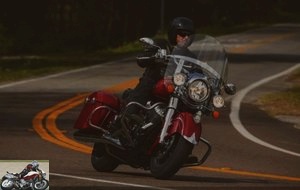
In terms of road holding, once the reserves inherent in a machine that weighs 400 kilos with refueling, which results in the adoption of relatively preventive driving, is taken into account, the Indian Springfield is attractive with its ability to make you forget its weight in most circumstances as well as by its agility and the quality of its suspensions.
Part-cycle
Compared to the Chief Vintage, the Springfield inaugurates a front axle with modified geometry. The caster angle is 31 ° with a 25 ° steering column axis and the caster 133 mm, instead of 31 °, 29 ° and 155 mm respectively. The handling of the Springfield is therefore supposedly more agile, with a center of gravity shifted a bit forward. However, it must be recognized that on the roads of Florida, on a route which included few turns and carried out at very reasonable speed, the difference in behavior did not jump out to us, even having taken a Chief Vintage for a short time to try to detect particularism of each. To be confirmed possibly during a subsequent test in the Morvan or in the Belgian Ardennes.
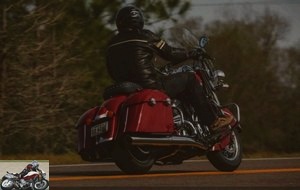
Note that the Springfield, like the other Indian Chiefs, has a pneumatic rear shock. The pump is delivered as standard. The adjustment is easy and a small table inside the left side cover lets you know the correct pressure.
Brakes
Three 300mm diameter discs are fitted to the Indian Springfield, clamped by 4-piston calipers at the front and two-piston at the rear. Braking is not coupled but ABS is standard, even in the USA where it is not mandatory in this market..
In a ride that respects its philosophy (and even pushing it a little harder), the Springfield’s braking calls for no criticism in terms of its power or dosage. As is often the case on American tourers, the rear brake is powerful, but the front end is also good if you pull the lever properly. There is then a little trim movement, the solid 46 mm diameter cartridge fork taking all the weight and offering 119 mm of travel to take the mass transfer..
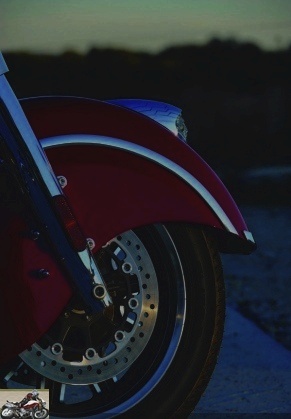
Comfort / duo
Springfield is a palace! Over the kilometers, the quality of the saddle and the damping appear to be major qualities of this machine decidedly dedicated to the reduction of kilometers. The greedy type. The pneumatically adjustable rear shock absorber allows this element to work in optimal conditions depending on the on-board load (it can be 242 kilos) and the driving rhythm required (in the case of “sporty” driving, take the values located two graduations above the on-board weight). Passengers will be happy to learn that its footrest plates are adjustable in height and inclination. Palace, I tell you !
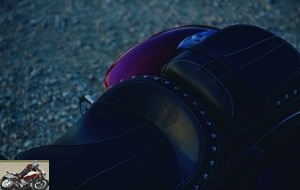
Over the miles shot, we realize that the general feeling of the bike and its controls also enters into the perceived comfort: everything falls well to hand, everything rings true, everything is perfectly calibrated. Indian has succeeded in giving all the controls a precise feeling, where the "density" of the control characteristic of an American machine with a strong pedigree is perfectly calibrated without ever being too hard and allows a perfect dosage. The result is a feeling of well-being that builds unshakably over the miles and then becomes quite addicting..
Conclusion
At € 27,000, the Indian Springfield definitely falls into the premium motorcycle category. This could be put in parallel with the 23,500 € requested for a Harley-Davidson Road King. But Indian is positioned as a more exclusive machine and the Springfield stands out for both the exceptional quality of its finish, the charm, character and power of its engine, as well as the balance of its chassis, which is more modern in design..
Indian has developed more than 180 accessories for the Sprinfield: different windshield heights, an Ape Hanger handlebars, footrest plates of different kinds and colors, a 64-liter top-case, a sissy-bar, the list is long. It also includes a dual branch selector.
What to do, in the great American tradition, a custom motorcycle, whose versatility will allow it to stand out in the city or to swallow long distances in a very high level of comfort.
Well, € 27,000, anyway! But as the great Michel Audiard (in Les Tontons Flingueurs, by Georges Lautner, in 1963) used to say to Pascal’s cousin (Lino Ventura’s first trigger) about his new pistol, “the price is forgotten, the quality remains. ". Because the new Indian is definitely a high quality motorcycle.
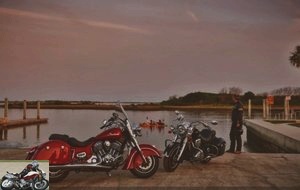
Strong points
- Exceptional finish and attention to detail
- Smooth, powerful and refined engine, with the accents of a carbureted V8 ….
- Very high level of comfort
- Global approval
- Unique sweet feeling on the market
- Road / cruising versatility
- Balanced part-cycle despite the weight
- 5 year warranty
Weak points
- No original dual branch selector
- Slightly long throttle pull
- Tariff specific to exceptional machines
Datasheet
Test conditions
- Itinerary: 285 km on the roads of Florida (USA), in a loop starting from Daytona Beach and going up to the pretty little town of Ste-Augustine.
- Motorcycle mileage: 60 km
- Problem encountered: none
Related articles
-
Indian Chieftain Limited Trial
The bagger is updated with aesthetic and mechanical evolutions V2, 1811 cm3, 84 hp at 5000 rpm, 150 Nm at 2100 rpm, 364 kilos dry, from € 28,850 With the…
-
Sexy sixty For his big comeback Indian combines his legendary Scout, in a less powerful, less worked and less expensive version. Closer to the aesthetics…
-
1731 cc, 89 hp, 139 Nm of torque, 296 dry kilos, € 13,490 An affordable, engaging and efficient power-cruiser with a very healthy chassis Mid-90s:…
-
Custom, live US cruiser or roadster Launched in 1920, the Indian Scout made a name for itself by defying the wall of death in 1928. Indian therefore…
-
Born on the earth, built for the road V-Twin of 1,203 cm3, 120 hp and 115 Nm, 221 kg dry, Sachs suspension, Brembo brakes, from 14,690 euros It had to…
-
Indian 1200 FTR Rally motorcycle test
Bite V-Twin, 1203 cm3, 120 hp, 120 Nm at 6,000 rpm, 235 kg TPF, 14,990 euros … daily test The word scrambler warms up lots of images, broadcast, told,…
-
The three-wheeler accessible in its 600 and 900 Rotax versions Should we still present the or rather the Can-Am, especially in France, which represents…
-
Discovering the…. thing …. Canadian Neither motorcycle, nor trike, nor auto roadster … The BRP Can Am Spyder is a bit of all of this at the same time…
-
Long-term test over 6,000 km from the chef’s custom to the 1811 cm3 Mythical is the adjective that best fits the brand Indian and not just for Burt…
-
Single cylinder, 411 cc, 24.5 hp at 6,500 rpm, 32 Nm at 4,000 rpm, 185 kilos, from € 4,495 A small, economical and versatile single-cylinder trail runner…
Excellent analysis, I had a Honda crossover until this year, the best compromise between the roadster and the trail often very typical TT look while their owners will only be on the road.
To travel quickly and well, once well equipped.
But sometimes you have to get rid of it, so goodbye 😂
For me the ideal displacement is the 800, both light, manoeuvrable in 17 "and quite powerful..
There is also the 1050 Tigersport which is unknown from Triumph in 3 cylinders
Yes, the KTM 1290 SA is also a competitor. We can even give its price, 17.899 €, its performance, 160 hp, 140 Nm, and its weight 238 kg.
We are not used to spare manufacturers, no doubt that you have read our last test BMW (or others) … Or not, finally.
Your sharp, even acerbic gaze should have seen that we find weak points in it, I doubt you will find any on the BMW site.
When a machine proves to be without major defects and qualitative although expensive we also keep our objectivity. This is what we expect from journalists …
We are not used to spare manufacturers, no doubt that you have read our last test BMW (or others) … Or not, finally.
Your sharp, even acerbic gaze should have seen that we find weak points in it, I doubt you will find any on the BMW site.
When a machine proves to be without major defects and qualitative although expensive we also keep our objectivity. This is what we expect from journalists…
"And it happened or the famous BMW check eh? Ahlala these journalists henchmen of Macronie"
#I’mWaboo